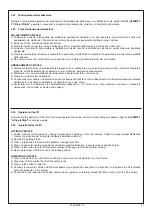
67
0750-M001-0
Quando sostituire i cavi del sollevatore a causa dei fili rotti
•
I cavi del sollevatore devono essere rimossi quando per ogni passo di cordatura vi siano visualizzabili sei fili rotti e casualmente
distribuiti, oppure tre fili rotti in uno stesso trefolo su un passo di cordatura.
Le tre componenti base di una fune tipica
Altre ragioni per sostituire i cavi del sollevatore
•
Corrosione che segna i fili e/o i connettori.
•
Traccia di annodamenti, schiacciamenti, tagli, deformazioni o anima saltata.
•
Usura che eccede il 10% del diametro originale del filo.
•
Traccia di danni da calore.
Come trovare i fili rotti
•
Innanzitutto stendere la fune (non tesa) in una posizione fissa e spostare i punti di raccolta dalla puleggia. Pulire la superficie
della fune con un panno - una spazzola metallica, se necessario - in modo da poter vedere ogni rottura.
•
Flettere la fune in modo da esporre i fili rotti nascosti tra i trefoli.
•
Controllare visivamente ogni eventuale filo rotto. Un modo per individuare ogni possibile sfilacciatura è quello di far scorrere
un panno lungo la fune.
•
Con una lesina, sondare tra i fili e i trefoli e sollevare ogni filo che sembra lento. Nel caso in cui venga individuata una rottura
interna ai fili, può essere necessario un esame più attento della fune.
- Controllare periodicamente che a sollevatore scarico la piattaforma mantenga la registrazione iniziale; in caso contrario
procedere come indicato al paragrafo ”Registrazione funi”.
When to replace lifting cables due to broken wires
•
Lifting cables should be removed from service when you see six randomly distributed broken wires within any one lay length,
or three broken wires in one strand within one lay length.
The three basic components of a typical wire rope
Other reasons to replace lifting cables
•
Corrosion that pits the wires and/or connectors.
•
Evidence of kinking, crushing, cutting, bird-caging or a popped core.
•
Wear that exceeds 10% of a wire's original diameter.
•
Evidence of heat damage.
How to find broken wires
•
The first step is to relax your rope to a stationary position and move the pick-up points off the sheaves. Clean the surface
of the rope with a cloth - a wire brush, if necessary - so you can see any breaks.
•
Flex the rope to expose any broken wires hidden in the valleys between the strands.
•
Visually check for any broken wires. One way to check for crown breaks is to run a cloth along the rope to check for possible
snags.
•
With an awl, probe between wires and strands and lift any wires that appear loose. Evidence of internal broken wires may require
a more extensive rope examination.
- At regular intervals, check that platform maintains initial setting under no load condition. If not so, follow procedure under “Cable
adjustment”.
CENTRE WIRE
STRAND
WIRE
CORE
WIRE ROPE
ONE LAY LENGHT
FILO CENTRALE
TREFOLO
FILO
ANIMA
FUNE
PASSO DI
CORATURA
Summary of Contents for 0750-M001-0
Page 9: ...SAFETY WARNING LABELS for Four Post Surface Mounted Roll on Lifts...
Page 10: ......
Page 11: ......
Page 14: ...0750 M001 0 14 Fig 2 1 1 G 14000 lbs...
Page 24: ...0750 M001 0 24 Fig 7...
Page 34: ...0750 M001 0 34 18 14 18 15 16 18 18 7 G Fig 12...
Page 36: ...0750 M001 0 36 Fig 13 5 4 6 8 9 7 1 3 2 10...
Page 38: ...0750 M001 0 38 Fig 14 7 8 6 3 4 5 1 3 2 10 11 9 3...
Page 40: ...0750 M001 0 40 Fig 15 1 5 2 4 3 3 1...
Page 42: ...0750 M001 0 42 Fig 16 EV3 2 A B C 1 3 4 6 D D EV3 E 7 7 9 8 5 10...
Page 48: ...0750 M001 0 48 Fig 19 1 2 3...
Page 52: ...0750 M001 0 52 1 3 2 4 Fig 21...
Page 54: ...0750 M001 0 54 Fig 22 3 1 5 5 5 4 4 5 2 6 Fig 23 1 2 3 2 1 3 2 2 Fig 24 4 5 6...
Page 60: ...0750 M001 0 60 2 Fig 25 1 3 4...
Page 62: ...0750 M001 0 62 Fig 27 Fig 26 3...
Page 99: ...99 99 0750 M001 0 NOTE NOTES...
















































